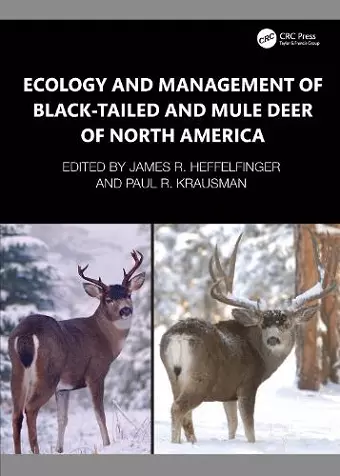Ecology and Management of Black-tailed and Mule Deer of North America
Paul R Krausman editor James R Heffelfinger editor
Format:Hardback
Publisher:Taylor & Francis Ltd
Published:27th Apr '23
Currently unavailable, our supplier has not provided us a restock date

Black-tailed and mule deer represent one of the largest distributions of mammals in North America and are symbols of the wide-open American West. Each chapter in this book was authored by the world’s leading experts on that topic. Both editors, James R. Heffelfinger and Paul R. Krausman, are widely published in the popular and scientific press and recipients of the O. C. Wallmo Award, given every two years to a leading black-tailed and mule deer expert who has made significant contributions to the conservation of this species. In addition, Heffelfinger has chaired the Mule Deer Working Group sponsored by the Western Association of Fish and Wildlife Agencies for more than 15 years. This working group consists of the leading black-tailed and mule deer experts from each of 24 states, provinces, and territories in western North America, putting them at the forefront of all conservation and much of the research on this species.
The book represents all current knowledge available on these deer, including how changing conditions such as fires, habitat alteration and loss, disease, climate change, socio-economic forces, energy development, and other aspects are influencing their distribution and abundance now and into the future. It takes a completely fresh look at all chapter topics. The revisions of distribution, taxonomy, evolution, behavior, and new and exciting work being done in deer nutrition, migration and movements, diseases, predation, and human dimensions are all assembled in this volume.
This book will instantly become the foundation for the latest information and management strategies to be implemented on the ground by practitioners and to inform the public. Although this book is about deer, the topics discussed influence most terrestrial wildlife worldwide, and the basic concepts in many of the chapters are applicable to other species.
This is not a book to be kept on a shelf for occasional, casual reading, nor can it be used effectively as a textbook on which to base an undergraduate or graduate course. Ecology and Management of Black‐Tailed and Mule Deer of North America is a comprehensive compilation of everything currently known about black‐tailed and mule deer. As such, it will be an invaluable resource for anyone with an interest in this iconic species. Graduate students
needing to brush up on basic life‐history traits of mule or black‐tailed deer will find everything they need to know in these pages. Biologists and managers wanting to implement new strategies for monitoring deer populations or for modifying deer habitat will find clear, accessible guidance. Even non‐professionals will find this a useful reference. This is the bible for anyone interested in mule or black‐tailed deer, and I know my copy won't just sit on my shelf.
Ryan A. Long, Department of Fish and Wildlife Sciences, University of Idaho, Moscow, Idaho, USA
Representing three subspecies of Odocoileus hemionus, black-tailed and mule deer are the iconic deer of western North America. Significant culturally, historically, economically, and spiritually, these deer have drawn a significant amount of attention in both technical and popular outlets. Until now, the most comprehensive volume on these deer was Mule and Black-Tailed Deer of North America, compiled and ed. by Olof Wallmo (1981), comprising 15 essays by 12 contributors. In the 40-years since 1981 much has changed and much has been learned. Wildlife scientists and managers have long been concerned over the steady decline in mule deer populations. Heffelfinger and Krausman, both respected experts, brought together 15 essays by a total of 82 authors. Readers at all levels, whether scientists, wildlife managers, students, or wildlife enthusiasts, will find this book readable yet packed with the most current science and technical information. Examples of topics represented in the present volume but not in the earlier book include chronic wasting disease, migration ecology, integrated population modeling, genetics, and finer treatments of ecoregional differences. The editors' care with this volume is evident throughout. It will be the definitive reference for this species.
-J. Organ, Emeritus, University of Massachusetts Amherst
ISBN: 9781032407609
Dimensions: unknown
Weight: 1620g
506 pages